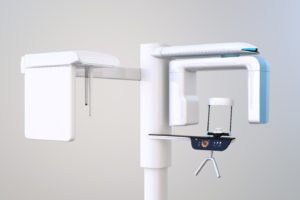


Dental implants have been around for several decades. Throughout the years, innovations in technology have improved this treatment to the point where it is successful in more than 95% of cases. In fact, it is considered to be the gold standard in tooth replacement. What specific types of technology make it so consistently successful? Let’s discuss just two tools that your dental implant dentist near Los Angeles may use to rebuild your smile.
CBCT stands for “cone beam computed tomography.” This tool, also known as a cone beam scanner, is essentially an advanced X-Ray machine. It uses a cone-shaped beam of radiation to capture highly detailed, three-dimensional images of a patient’s jawbone and remaining natural teeth. It can even allow a dentist to see a patient’s nerves and connective tissues.
The CBCT machine plays a pivotal role in treatment planning. It gives your dentist the opportunity to determine exactly where, at what angle, and how deep dental implants should be placed in the mouth. It also aids in the selection of the specific size of implant that should be used.
CBCT scans can reduce or eliminate surprises during implant placement surgery and thereby lower the risk of complications and dental implant failure. After the implants are placed, it can help a dental team to monitor osseointegration (in other words, it allows them to see how well an implant is bonding with the surrounding bone).
After your implants have fully integrated with your bone, the time will come for your dentist to design your new crown, bridge, or denture. In the past, there was no option but to use old-fashioned putty to capture dental impressions during the design process. Today, though, an easier alternative is available.
A digital impression scanner uses a wand-like device to capture thousands of images of the mouth. Then, advanced software assembles those images into a digital, three-dimensional representation of the dental arches. It provides a highly accurate framework upon which the design of your custom new teeth will be based.
In addition to its accuracy, a digital impression scanner offers even more advantages. For example, it is faster than traditional impressions, and many patients find it to be more comfortable as well.
Not every dentist uses the latest in dental implant technology. Some still use X-Rays instead of a CBCT machine and putty instead of digital impressions. Before you commit to treatment with a practice, find out what kind of instruments they have at their disposal. Your diligence will enable you to enjoy the smoothest, lowest-risk dental implant experience possible.
Meet the Practice
Dr. Idan Snapir is the lead doctor at OraBell Dental Implant Centers near Los Angeles. He has more than 20 years of experience in the realm of dentistry, and throughout that time, he has always been interested in using the best technology for his patients. Our office is proud to have both a CBCT machine and digital impression scanner. If you would like to learn more about dental implants and what is involved in the treatment process, contact us at 818-446-9988.
No comments yet.
RSS feed for comments on this post.
Sorry, the comment form is closed at this time.